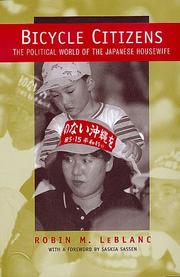| Listing 1 - 6 of 6 |
Sort by
|

ISBN: 0520914376 0585101469 9780520914377 9780585101460 0520084217 9780520084216 Year: 1988 Publisher: Berkeley University of California Press
Abstract | Keywords | Export | Availability | Bookmark
 Loading...
Loading...Choose an application
- Reference Manager
- EndNote
- RefWorks (Direct export to RefWorks)
Women social reformers --- Radicalism --- Extremism, Political --- Ideological extremism --- Political extremism --- Political science --- Social reformers --- History --- Japan --- Social conditions --- J4000.80 --- J4010 --- J4176.80 --- Japan: Social history, history of civilization -- Gendai (1926- ), Shōwa period, 20th century --- Japan: Social sciences in general -- ideology, socio-political and socio-economic movements --- Japan: Sociology and anthropology -- gender roles, women, feminism -- history --- Social reform --- Role of --- Women
Book
ISBN: 0819577804 9780819577801 9780819577788 0819577782 9780819577788 9780819577795 0819577790 Year: 2018 Publisher: Middletown, Connecticut
Abstract | Keywords | Export | Availability | Bookmark
 Loading...
Loading...Choose an application
- Reference Manager
- EndNote
- RefWorks (Direct export to RefWorks)
In this first book-length study of chindon-ya, Marie Abe investigates the intersection of sound, public space, and sociality in contemporary Japan. Chindon-ya, dating back to the 1840s, are ostentatiously costumed street musicians who publicize a business by parading through neighborhood streets. Historically not considered music, but part of the everyday soundscape, this vernacular performing art provides a window into shifting notions of musical labor, the politics of everyday listening and sounding, and street music at social protest in Japan. Against the background of long-term economic downturn, growing social precarity, and the visually and sonically saturated urban streets of Japan, this book examines how this seemingly outdated means of advertisement has recently gained traction as an aesthetic, economic, and political practice after decades of inactivity. Resonances of Chindon-ya challenges Western conceptions of listening that have normalized the way we think about the relationship between sound, space, and listening subjects, and advances a growing body of interdisciplinary scholarship that examines the ways social fragmentation is experienced and negotiated in post-industrial societies.
Street musicians --- Music in advertising --- Street music --- Music --- Chindon-ya. --- Marching bands --- Art music --- Art music, Western --- Classical music --- Musical compositions --- Musical works --- Serious music --- Western art music --- Western music (Western countries) --- Street music and musicians --- Advertising --- History and criticism. --- Social aspects --- Chindon-ya --- J4365 --- J4010 --- J6700 --- History and criticism --- Japan: Economy and industry -- business methods and management -- marketing and advertising --- Japan: Social sciences in general -- ideology, socio-political and socio-economic movements --- Japan: Performing arts and entertainment -- music

ISBN: 0520923324 0585108404 9780520923324 9780585108407 9780520085701 0520085701 0520219619 9780520219618 0520085701 Year: 1995 Publisher: Berkeley University of California Press
Abstract | Keywords | Export | Availability | Bookmark
 Loading...
Loading...Choose an application
- Reference Manager
- EndNote
- RefWorks (Direct export to RefWorks)
This first ethnographic study of factory workers engaged in radical labor protest gives a voice to a segment of the Japanese population that has been previously marginalized. These blue-collar workers, involved in prolonged labor disputes, tell their own story as they struggle to make sense of their lives and their culture during a time of conflict and instability. What emerges is a sensitive portrait of how workers grapple with a slowed economy and the contradictions of Japanese industry in the late postwar era. The ways that they think and feel about accommodation, resistance, and protest raise essential questions about the transformation of labor practices and limits of worker cooperation and compliance.
Labor unions --- Working class --- Labor movement --- Class consciousness --- Industrial relations --- Labor & Workers' Economics --- Business & Economics --- Japan --- Social conditions --- Consciousness --- Social perception --- Social classes --- J4010 --- J4202 --- J4350 --- J4352 --- Japan: Social sciences in general -- ideology, socio-political and socio-economic movements --- Japan: Sociology and anthropology -- communities -- social classes and groups -- middle class, shi-nō-kō-shō --- Japan: Economy and industry -- labor and employment --- Japan: Economy and industry -- labor and employment -- social conditions --- Conscience de classe --- Relations industrielles --- Mouvement ouvrier --- Syndicats --- Travailleurs --- Japon --- Conditions sociales --- 1945 --- -Trade-unions - Japan. --- Working class - Japan. --- Social movements - Japan. --- Class consciousness - Japan. --- Japan - Social conditions - 1945 --- -Class consciousness --- -Labor unions --- accommodation. --- blue collar workers. --- class consciousness. --- community. --- democracy. --- demonstrations. --- economy. --- ethnography. --- factories. --- factory workers. --- japan. --- japanese history. --- japanese industry. --- japanese labor history. --- japanese society. --- japanese unions. --- labor disputes. --- labor movements. --- labor practices. --- labor relations. --- labor. --- political action. --- protest. --- protests. --- radical labor protest. --- resistance. --- social relations. --- solidarity. --- union meetings. --- union. --- work. --- worker compliance. --- worker cooperation. --- worker dignity. --- Trade-unions - Japan.
Book
ISBN: 9780801453762 0801453763 9781501703379 1501703374 1501703366 9781501703362 Year: 2016 Publisher: Ithaca London
Abstract | Keywords | Export | Availability | Bookmark
 Loading...
Loading...Choose an application
- Reference Manager
- EndNote
- RefWorks (Direct export to RefWorks)
Government wrongdoing or negligence harms people worldwide, but not all victims are equally effective at obtaining redress. In Accidental Activists, Celeste L. Arrington examines the interactive dynamics of the politics of redress to understand why not. Relatively powerless groups like redress claimants depend on support from political elites, active groups in society, the media, experts, lawyers, and the interested public to capture democratic policymakers' attention and sway their decisions. Focusing on when and how such third-party support matters, Arrington finds that elite allies may raise awareness about the victims' cause or sponsor special legislation, but their activities also tend to deter the mobilization of fellow claimants and public sympathy. By contrast, claimants who gain elite allies only after the difficult and potentially risky process of mobilizing societal support tend to achieve more redress, which can include official inquiries, apologies, compensation, and structural reforms. Arrington draws on her extensive fieldwork to illustrate these dynamics through comparisons of the parallel Japanese and South Korean movements of victims of harsh leprosy control policies, blood products tainted by hepatitis C, and North Korean abductions. Her book thereby highlights how citizens in Northeast Asia-a region grappling with how to address Japan's past wrongs-are leveraging similar processes to hold their own governments accountable for more recent harms. Accidental Activists also reveals the growing power of litigation to promote policy change and greater accountability from decision makers.
J4000.90 --- J4010 --- J4600.90 --- K9309 --- K9300.80 --- K9500.80 --- Japan: Social history, history of civilization -- postwar Shōwa (1945- ), Heisei period (1989- ), contemporary --- Japan: Social sciences in general -- ideology, socio-political and socio-economic movements --- Japan: Politics and law -- history -- postwar Shōwa (1945- ), Heisei period (1989- ), contemporary --- Korea: Social sciences, society -- social theory, movements and protests --- Korea: Social sciences -- social and cultural history -- modern period, postwar period (1945- ) --- Korea: Politics -- history -- modern period, postwar period (1945- ) --- Victims --- Government liability --- Political participation --- Government immunity --- Government responsibility --- Liability, Government --- Liability, Public --- Liability of the state --- Public liability --- Sovereign immunity --- State liability --- State responsibility --- Tort liability of the government --- Tort liability of the state --- Administrative law --- Administrative responsibility --- Constitutional law --- Liability (Law) --- Misconduct in office --- Public law --- Torts --- Act of state --- Constitutional torts --- State action (Civil rights) --- Persons --- Political activity --- Law and legislation --- Political activity.

ISBN: 0520920619 0585241392 9780520920613 9780585241395 9780520212909 0520212908 9780520212916 0520212916 0520212908 0520212916 Year: 1999 Publisher: Berkeley, California : University of California Press,
Abstract | Keywords | Export | Availability | Bookmark
 Loading...
Loading...Choose an application
- Reference Manager
- EndNote
- RefWorks (Direct export to RefWorks)
While the typical Japanese male politician glides through his district in air-conditioned taxis, the typical female voter trundles along the side streets on a simple bicycle. In this first ethnographic study of the politics of the average female citizen in Japan, Robin LeBlanc argues that this taxi-bicycle contrast reaches deeply into Japanese society. To study the relationship between gender and liberal democratic citizenship, LeBlanc conducted extensive ethnographic fieldwork in suburban Tokyo among housewives, volunteer groups, consumer cooperative movements, and the members of a committee to reelect a female Diet member who used her own housewife status as the key to victory. LeBlanc argues that contrary to popular perception, Japanese housewives are ultimately not without a political world. Full of new and stimulating material, engagingly written, and deft in its weaving of theoretical perspectives with field research, this study will not only open up new dialogues between gender theory and broader social science concerns but also provide a superb introduction to politics in Japan as a whole.
Women --- Housewives --- Political participation --- Gender & Ethnic Studies --- Social Sciences --- Gender Studies & Sexuality --- Homemakers --- Mothers --- Wives --- Human females --- Wimmin --- Woman --- Womon --- Womyn --- Females --- Human beings --- Femininity --- Political activity --- Social conditions --- #SBIB:316.346H20 --- #SBIB:324H60 --- J4010 --- J4176 --- Positie van de vrouw in de samenleving: algemeen --- Politieke socialisatie --- Japan: Social sciences in general -- ideology, socio-political and socio-economic movements --- Japan: Sociology and anthropology -- gender roles, women, feminism --- Women in politics --- 20th century japanese culture. --- 20th century japanese politics. --- community service. --- consumer cooperative movements. --- elite politics. --- ethnography. --- female diet member. --- field research. --- fieldwork. --- gender studies. --- gender theory. --- housewives. --- japan. --- japanese citizenship. --- japanese culture. --- japanese housewives. --- japanese male politician. --- japanese politics. --- japanese society. --- japanese women. --- liberal democratic citizenship. --- political world. --- politics. --- regular housewife. --- social science. --- sociology. --- the ono campaign. --- tokyo. --- volunteer groups.
Book
ISBN: 1501715062 9781501715068 9781501715051 1501715054 9781501715044 1501715046 9781501715044 Year: 2018 Publisher: Ithaca, NY
Abstract | Keywords | Export | Availability | Bookmark
 Loading...
Loading...Choose an application
- Reference Manager
- EndNote
- RefWorks (Direct export to RefWorks)
"A cultural history of the relationship between art and politics in Japan, 1945-1960. Highlights the transformational nature of the early postwar period against the relative stasis, consolidation, and homogenization of the 1960s. Provides insight into the present by focusing on a period similarly characterized by decentralization and de-professionalization of culture and expansion of conceptions of what art is and who should be doing it"--
Art, Japanese --- Art and social action --- Art --- Art, Occidental --- Art, Visual --- Art, Western (Western countries) --- Arts, Fine --- Arts, Visual --- Fine arts --- Iconography --- Occidental art --- Visual arts --- Western art (Western countries) --- Arts --- Aesthetics --- Social action and art --- Social action --- Monoha (Group of artists) --- History --- Political aspects --- J6008.90 --- J4010 --- J4000.90 --- J6020 --- Japan: Art and antiquities -- history -- postwar Shōwa (1945- ), Heisei period (1989- ), contemporary --- Japan: Social sciences in general -- ideology, socio-political and socio-economic movements --- Japan: Social history, history of civilization -- postwar Shōwa (1945- ), Heisei period (1989- ), contemporary --- Japan: Art and antiquities -- Japanese aesthetics (Japonism) --- relationship between art and politics in Japan, participatory cultural forms, Cold War, social realists on the radical left, liberal art education movement. --- Art, Primitive
| Listing 1 - 6 of 6 |
Sort by
|

 Search
Search Feedback
Feedback About UniCat
About UniCat  Help
Help News
News